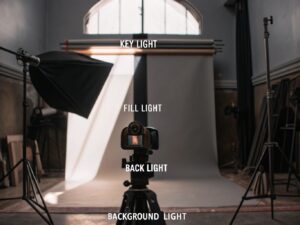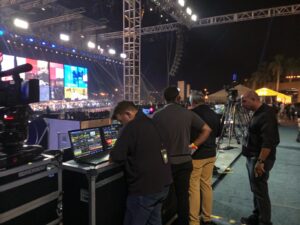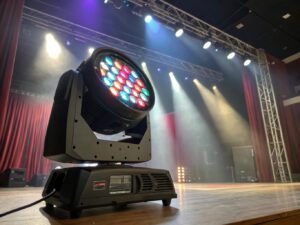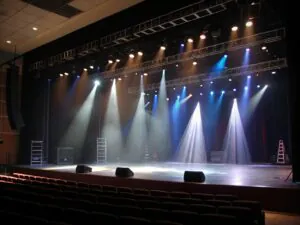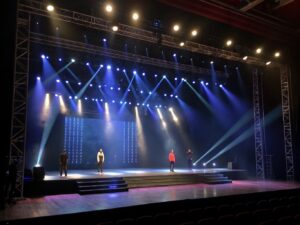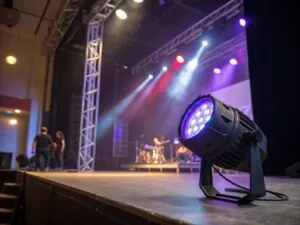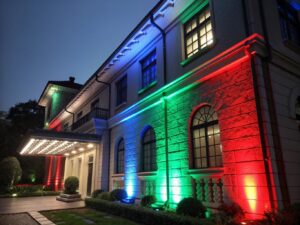
Does your church lighting feel outdated or distracting? It can hinder the worship experience. This guide will give you a clear path to creating a powerful, focused atmosphere1 with light.
Mastering modern worship lighting involves understanding core fixtures, applying design principles like three-point lighting, and planning strategically for both your in-person congregation and online livestream. The focus is on enhancing the atmosphere, not creating a concert.

In my 19 years in this industry, I've seen how lighting can transform a space. It’s not just for rock concerts. In a church, it's a powerful ministry tool that helps deliver the message and draw the congregation into worship. Let's dive into how to use it effectively, starting with why it’s so important in the first place.
Why is strategic lighting crucial for today's church?
Think lighting is just a "nice-to-have" extra? That mindset misses a huge opportunity to connect more deeply with your congregation. Let's explore its core role in modern worship.
Strategic lighting is crucial because it sculpts the worship atmosphere, directs focus to the message, and makes your livestream2 look professional. It directly supports the ministry's communication goals, engaging both in-person and online attendees.

Strategic lighting does more than just make the stage bright. It is a communication tool3 that can drastically shape everyone's experience. In today's hybrid church model, its role is more critical than ever.
Enhance Atmosphere & Focus Attention
Imagine soft blues and purples washing over the room as the band leads a quiet, reflective song. It helps calm the hearts of the congregation. When the pastor speaks, a clean, warm light makes him the visual anchor, drawing everyone's attention to the message. Lighting tells people non-verbally, "Pay attention to this now."
Elevate the In-Person Experience
For the people in the room, lighting can turn a generic room into a sacred space4. It can erase the cold, institutional feel of fluorescent lights. With thoughtful lighting, you create a warm, welcoming environment that helps people feel comfortable and focused from the moment they walk in.
The Decisive Role of Lighting for Quality Livestreams
The human eye is very forgiving, but a camera lens is not. Bad lighting on a livestream becomes a grainy, flat, and discolored picture. Good lighting is the foundation of a professional-looking stream5. It ensures the speaker's face is clear, eliminates ugly shadows, and makes the entire presentation look vibrant and engaging for your online audience.
Core Fixtures: Understanding Your Church Lighting Toolbox?
Feeling lost in a sea of technical terms? Choosing the wrong fixtures will waste your budget. Let's simplify your toolbox down to the absolute essentials.
A church lighting toolbox needs hard-edged lights (spots/profiles) for key elements, soft-edged lights (washes/PARs) for atmosphere, and effects lights for drama. A balance of these fixture types forms the foundation of any versatile and effective church lighting system.

Building a lighting system is like putting together a worship band; you need different instruments to create a harmonious sound. Understanding what each light does will help you make the smartest investment for your budget.
Key & Profile Lights (Hard-Edged): For Highlighting Speakers & Key Elements
These fixtures, like profile or leko lights, project a sharply defined beam. They are your "scalpels," perfect for precisely lighting a pastor during a sermon, ensuring they are seen clearly without light spilling onto the background screen. You can also use them to project patterns (gobos) or highlight a key visual element like a cross.
Wash & Flood Lights (Soft-Edged): For Broad Coverage & Creating Atmosphere
These fixtures, like PAR cans or wash moving heads, produce a soft-edged, wide field of light. They are your "paintbrushes," used to color the entire stage or a backdrop wall. During musical worship, you can use them to shift colors and change the entire mood of the room, moving seamlessly from joyful celebration (warm colors) to deep reflection (cool colors).
Accent & Effects Lights (Beams, Pin Spots): For Dramatic Effect & Architectural Features
These are used for emphasis. For example, a narrow beam light can create striking mid-air effects for a celebration or youth event. A pin spot can be used to subtly highlight an architectural detail or a decorative element, adding visual depth to the space.
LED vs. Traditional Fixtures: A Pro/Con List for Churches
Today, LED is the clear choice for the vast majority of churches.
| Feature | LED Fixtures | Traditional (Halogen) Fixtures |
|---|---|---|
| Energy Efficiency | Very High (80% less power) | Very Low |
| Heat Generation | Minimal | Very High (adds to A/C load) |
| Color | Built-in color mixing, millions of options | Requires physical gels, limited colors |
| Lifespan | Long (20,000+ hours) | Short (a few hundred hours) |
| Upfront Cost | Higher | Lower |
| Long-Term Cost | Very Low | Higher (electricity, lamp replacement) |
The Art of Design: Church Lighting Principles & Techniques?
You have the right gear, but the stage still looks flat? Good equipment requires a good plan. Let’s learn a few basic rules of lighting design.
The art of church lighting lies in applying three-point lighting for clarity, using color to influence mood, and carefully balancing brightness across the stage. It’s about being intentional to support each moment, not just turning on the lights.

Design is more than just technical; it's an art. It's about guiding how people feel and where they look. Mastering a few basic principles can empower even a volunteer team to create professional results.
Three-Point Lighting: The Foundation for a Professional Look
This is the golden rule for making a speaker or host look natural and three-dimensional, especially for a livestream.
- Key Light: Your main source, coming from the front at an angle (about 45 degrees).
- Fill Light: Comes from the opposite front angle, slightly dimmer, to fill in the shadows created by the key light.
- Back Light: Shines on the person from behind to create a subtle rim of light on their hair and shoulders, separating them from the background.
Strategic Placement: How to Position Front, Back, and Fill Lights
Your front lights (key and fill) should be positioned at about a 45-degree vertical angle to avoid creating unnatural shadows on the face. The back light should be high and directly behind the subject. For musicians, top light or high side light often works best so they can see their instruments and music without being blinded.
Using Color Theory to Shape the Worship Experience
Color has a direct emotional impact.
- Warm Colors (Ambers, Oranges, Reds): Create a sense of welcome, celebration, and energy. Great for upbeat songs or the start of a service.
- Cool Colors (Blues, Cyans, Purples): Create a mood of contemplation, reverence, and peace. Ideal for prayer, reflection, or slower songs.
- Neutrals (White, Light Lavenders): Perfect for the sermon. It's clear, natural, and not distracting.
Balancing Brightness: Setting the Right Levels for Different Zones
Not everything on stage should be equally bright. Create a visual hierarchy6. The speaker should be the brightest, followed by the worship leader, then the band and choir. The background should be the dimmest. The house lights over the congregation should be low enough to direct focus to the stage, but bright enough for "safe to read your Bible."
Practical Lighting Scenarios for Different Worship Segments?
The theory is great, but how do you apply it to an actual service flow? The wrong lighting scene can disrupt the transition between moments. Let's look at some specific examples.
Creating preset scenes for each segment is key. Use bright, natural three-point lighting for the sermon; use soft, colored washes for worship; and use focused top lighting for special moments like a baptism. This ensures seamless, professional transitions.

Creating preset scenes for different parts of the service greatly simplifies operation, allowing even inexperienced volunteers to run the show with confidence.
Lighting Ideas for the Pulpit, Altar, and Main Stage
For the sermon, clarity is the goal. Use neutral white light in a three-point setup. You can project a very soft, non-distracting color or texture onto the back wall to add visual depth, especially for the camera shot.
How to Properly Light the Choir and Musician Areas
The band and choir need functional lighting. Use top lights or high side lights to illuminate them and their music without shining directly in their eyes. Use a gentle color wash to blend them into the overall stage picture, but keep them at a lower brightness level than the main speaker.
Techniques for Highlighting a Cross or Architectural Feature
For an important feature like a cross or a stained-glass window, use a very narrow, focused beam of light (from a profile/leko) to illuminate it precisely. This light should be static and constant, remaining on throughout the service as a visual anchor that continually draws people's focus to the core of the faith.
Before You Buy: Budgeting & Choosing a Vendor?
Ready to upgrade, but not sure where to start spending? A lack of planning can lead to overspending or buying the wrong gear. Let's learn how to plan and purchase wisely.
Before buying, create a phased budget based on your church's goals. Then, find a reputable vendor who understands your ministry needs and ask them key questions about support, training, and warranties.

A smart investment starts with a good plan. This process ensures every dollar you spend provides real value and serves your ministry for the long term.
How to Create a Realistic Budget for Church Lighting
| I recommend thinking about your budget in phases instead of trying to do everything at once. | Budget Level | Goal | Likely Equipment |
|---|---|---|---|
| Entry Level | Improve sermon lighting & livestream clarity | 2-4 LED profile spots (for three-point lighting), basic lighting controller. | |
| Intermediate | Add atmospheric capabilities | Add 4-8 LED wash lights (PARs) to the Entry setup, upgrade controller. | |
| Professional | Achieve fully dynamic & versatile design | Add moving head fixtures, advanced controller, and specialty effects lights. |
10 Key Questions to Ask a Lighting Vendor Before Signing
Choosing a partner is as important as choosing the equipment. As the founder of Monalight, I know the value of building that trust.
- Can you provide references from churches of a similar size and style to ours?
- What installation and commissioning services are included in the quote?
- What kind of training do you provide for our volunteer team?
- What is the warranty period on the core components of the fixtures (like the LED engine)?
- What is the repair process if a fixture fails under warranty?
- How easily can this system be expanded in the future?
- What is your technical support response time?
- Does this quote include all necessary cables and accessories?
- Can you help us plan for maximum energy efficiency?
- In your opinion, what is the most critical investment in this proposal for our church?
Long-Term Success: Maintenance & Energy Efficiency?
Is the new system installed and now you're done? Neglecting maintenance will shorten the life of your equipment and increase long-term costs. Let's build a simple plan to protect your investment.
For long-term success, create a simple, regular maintenance checklist7 for tasks like cleaning lenses and checking cables. Also, maximize energy efficiency8 with LEDs and smart control to significantly lower your long-term operating costs.

A good lighting system should serve you reliably for years. A few simple habits can ensure it does.
A Simple Lighting System Maintenance Checklist
- Quarterly: Clean the lenses of all fixtures with a soft cloth and proper cleaning solution. Dust can reduce brightness by 30% or more.
- Quarterly: Check that fixture fans are running correctly and clear any dust from the air intakes.
- Bi-Annually: Check all rigging points to ensure safety clamps and cables are secure.
- Bi-Annually: Inspect all power and data cables for any signs of wear and tear.
- Annually: Consider having a professional perform a full system check-up.
Maximizing Energy Efficiency to Lower Long-Term Costs
- Go All LED: If you still have traditional fixtures, replacing them with LEDs is the single most effective way to lower your power bill.
- Use Presets: Avoid running all lights at full brightness when it isn't necessary.
- "All Off" Scene: Program a scene on your controller that turns off all non-essential lights with one button press. This prevents fixtures from being left on by mistake after a service.
- Smart Power: Use a power sequencer to ensure equipment is turned on and off in the correct order, protecting the circuits.
Church Lighting FAQ?
Still have some common questions about church lighting? The wrong assumptions can stop you from making the best decisions. Let's answer some of the most frequently asked questions.
This section answers core user questions about budget, volunteers, livestream impact, and more. The key takeaway is that lighting should always serve the ministry goal, and modern systems are easier to learn and use than ever before.

After working with many churches, I've found that a few questions come up again and again. Here are direct answers to some of the most important ones.
-
Our budget is very tight. What is the very first thing we should invest in?
- Invest in three-point lighting for your pulpit. Clearly illuminating the speaker is priority number one. Two good-quality LED profile spots and a simple controller will dramatically improve your livestream and in-person focus.
-
Our tech team is all volunteers. Can they run complex lighting?
- Yes. Modern lighting controllers are becoming much more user-friendly. The key is to have your system set up with preset scenes. That way, a volunteer just has to press buttons labeled "Sermon," "Song 1," "Prayer," etc., without needing to know the complex programming behind it.
-
Will lights make our church feel like a concert?
- Only if you program them that way. Good church lighting design is about restraint. The goal is to support and enhance, not distract. Gentle colors and natural white light will create an atmosphere of worship, not a performance.
-
Do we need a separate lighting system for our livestream?
- Not necessarily. A well-designed system can serve both your live audience and the camera. The key is to plan for the camera's needs—ensuring enough brightness and consistent color temperatures—from the very beginning.
-
What is DMX, and do I need to understand it?
- DMX is the industry-standard language that lighting fixtures use to talk to the controller. You don't need to be an expert, but you should know it's how everything connects. A good vendor will set all of this up for you.
Conclusion
Mastering church lighting is about learning to use the right tools and techniques to create a focused, worshipful environment that better serves both your in-person and online congregations.
-
Learn how to create a welcoming and focused atmosphere for your congregation through lighting. ↩
-
Discover how to make your livestreams look professional and engaging with proper lighting. ↩
-
Learn how lighting can enhance communication and engagement during services. ↩
-
Discover how thoughtful lighting can transform a generic room into a sacred worship environment. ↩
-
Find out how to achieve a polished look for your church's livestream with proper lighting. ↩
-
Understanding visual hierarchy can help you direct focus effectively during services. ↩
-
Ensure the longevity of your lighting system with a proper maintenance plan. ↩
-
Explore strategies to reduce energy costs while maintaining effective lighting. ↩
You may also be interested in:
